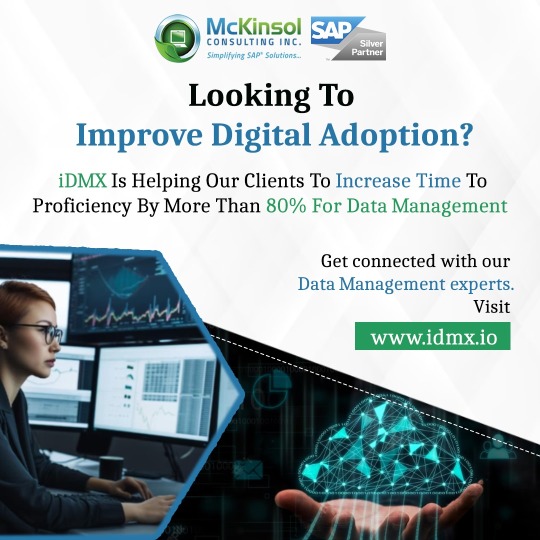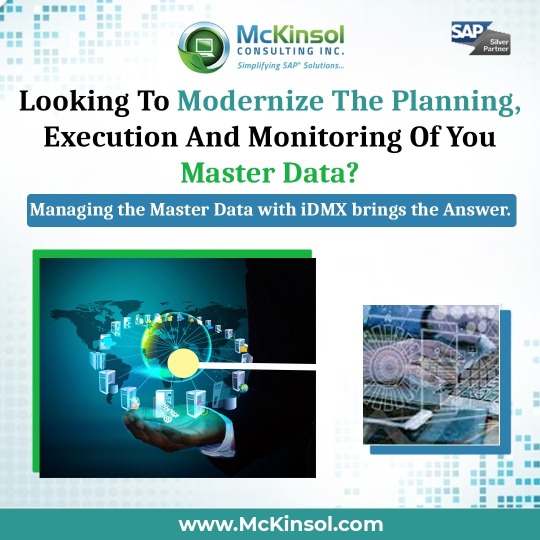#MasterData
Explore tagged Tumblr posts
Text
Data Stewards
The term data steward never resonated well with me; I prefer the terminology business data owners, as this term conveys a stronger sense of responsibility. The role should mandate authority and respect while it is there to safeguard the integrity and value of data. So, let’s dive into and define what data stewards are—individuals appointed to oversee the data quality for specific domains or…
#business data owners#Data administrators#Data caretakers#Data controllers#Data custodians#Data guardians#Data Heroes#Data managers#data stewards#Data supervisors#Information stewards#masterdata
0 notes
Text
#MasterDataManagementTools#MasterDataManagementSolutions#MasterData#MasterDataGovernance#MDMSystems#MDMMasterDataManagement#MasterDataManagementVendors#MDMData#MasterDataManagementPlatforms#MasterDataManagementStrategy
0 notes
Text
Navigating Data Management Excellence: A Deep Dive into Distinct MDM Paradigms
In the digital age, data is the lifeblood of any organization. But with vast amounts of information scattered across different systems and formats, maintaining accuracy, consistency, and completeness can be a daunting challenge. This is where Master Data Management (MDM) comes in, offering a strategic approach to managing your critical data assets.
The Evolving Landscape of MDM:
Traditionally, MDM solutions focused on managing data within a single domain, like customer or product information. However, as businesses grow and data needs diversify, these limitations become apparent.
Dissecting the MDM Approaches:
Single Domain MDM: This targeted approach tackles data quality within a specific domain, offering a straightforward solution for organizations with limited data complexity. Think of it as focusing on one piece of the puzzle.
Multi-Domain MDM: This holistic approach expands the scope, connecting various data types for a unified view. Imagine seamlessly linking customer data with product information, enabling informed decisions across the board.
Multiple Domain MDM: This decentralized approach manages independent instances for each domain, catering to unique requirements but potentially increasing complexity. Think of it as managing separate puzzles simultaneously.
The Rise of Multi-Domain MDM:
Multi-Domain MDM emerges as a frontrunner, empowering organizations to manage all their master data in one centralized hub.
Multi-Domain MDM, as a modern approach, empowers organizations to centralize the management of all master data, irrespective of the domain. This encompasses customer data, product data, supplier data, financial data, and more. The advantages of Multi-Domain MDM over traditional solutions are manifold, including improved data accuracy and consistency, enhanced decision-making capabilities, increased operational efficiency, and reduced costs through the elimination of data silos.
This "golden record" encompasses customer, product, supplier, financial, and more, offering several key benefits:
Enhanced Data Accuracy & Consistency: Eliminating silos ensures consistent, reliable data across all domains.
Improved Decision-Making: Accurate data fuels better choices regarding customers, products, and operations.
Increased Operational Efficiency: Streamlined processes optimize data management, saving time and effort.
Reduced costs: By eliminating data silos and improving data quality, multi-domain MDM can help organizations reduce costs.
Choosing the Right Fit:
Choosing the right approach hinges on various factors, including the size and complexity of the organization. Larger and more complex organizations may find Multi-Domain MDM more suitable for managing all master data effectively. Additionally, the organization's data governance practices play a pivotal role in the success of MDM, irrespective of the chosen approach.
The decision between Multi-Domain MDM and Single-Domain MDM depends on the unique requirements, size, complexity, and budget considerations of each organization. It is essential to carefully assess these factors to determine the most fitting MDM strategy for optimizing data management processes and fostering informed decision-making.
Empower your businesses to centralize and streamline your master data across various domains, fostering accuracy, consistency, and efficiency by eliminating data silos and providing a holistic perspective. Verdantis stands out as a comprehensive solution provider, capable of addressing the diverse needs of organizations navigating the complexities of data management and by facilitating better decision-making and operational excellence. Whether you opt for Single Domain MDM or embrace the broader scope of Multi-Domain MDM, Verdantis is committed to delivering tailored solutions that align with your organization's size, complexity, and budgetary considerations. Get In Touch with Verdantis to embark on a journey towards optimized data management, informed decision-making, and sustained competitive advantage.
Write To Us: [email protected]
References:
com/pulse/debating-single-versus-multi-domain-mdm-clinton-jones/?trk=pulse-article_more-articles_related-content-card
com/kellton-tech-blog/what-is-multidomain-master-data-management
com/blogs/the-growing-significance-of-multidomain-mdm/
0 notes
Text
Improve Digital Adoption
Seeking to enhance digital adoption? iDMX is assisting our clients in boosting proficiency time by over 80% for Data Management..!!
Contact us at: https://mckinsol.com/contact-us/ For More Information: www.mckinsol.com
Get Regular Updates:
➽Facebook: https://www.facebook.com/mckinsol
➽LinkedIn: https://www.linkedin.com/company/mckinsol
➽Twitter: https://twitter.com/mckinsol

0 notes
Text
What are some best practices for integrating a PIM system with other business systems, such as ERP, CRM, and e-commerce platforms?
Integrating a Product Information Management (PIM) system with other business systems, such as ERP (Enterprise Resource Planning), CRM (Customer Relationship Management), and e-commerce platforms, is essential to streamline operations and ensure consistency in product data across the organization. Here are some best practices for successful integration:

Define Clear Objectives: Before starting any integration project, clearly define your objectives. Understand what you want to achieve with the integration, such as improving data accuracy, enhancing customer experiences, or streamlining order processing.
Select the Right PIM Solution: Choose a PIM system that offers robust integration capabilities and supports the specific business systems you need to connect. Evaluate whether the PIM solution provides APIs, connectors, or plugins for seamless integration.
Data Mapping and Standardization: Ensure that data from the PIM system is mapped correctly to the data fields in the target systems. Standardize data formats, naming conventions, and data structures to achieve consistency across all integrated systems.
Data Synchronization Strategy: Determine the frequency and direction of data synchronization between the PIM system and other systems. Consider whether data should flow one-way or bi-directionally. Define rules for data updates, including real-time or batch processing.
Data Transformation and Validation: Implement data transformation and validation routines to ensure that data transferred between systems is accurate and complies with the specific requirements of each system. Use data quality checks to identify and correct errors during integration.
Error Handling and Logging: Develop robust error-handling mechanisms to address issues that may arise during integration. Implement logging and monitoring to track data transfer and identify any failed transactions or discrepancies.
Security and Authentication: Implement strong security measures to protect data during integration. Use authentication protocols and encryption to ensure data is transmitted securely between systems. Grant access only to authorized users and systems.
Scalability and Performance: Consider the scalability and performance requirements of your integration. Ensure that the integration can handle increased data volumes as your business grows. Optimize data transfer processes to minimize latency and maximize efficiency.
Testing and Validation: Rigorously test the integration before deployment. Conduct functional, performance, and regression testing to verify that data flows correctly and that all business rules are enforced. Involve end-users in user acceptance testing (UAT) to ensure the integration meets their needs.
Documentation and Training: Document the integration process, including data mappings, transformation rules, and error-handling procedures. Provide training to relevant personnel who will be involved in monitoring, managing, or troubleshooting the integration.
Change Management: Prepare for changes in workflows and processes resulting from the integration. Communicate these changes to affected teams and provide support and training as needed to ensure a smooth transition.
Continuous Monitoring and Maintenance: After integration, establish ongoing monitoring and maintenance processes. Regularly review the integration for performance issues, data quality problems, and compliance with evolving business needs.
Vendor and Partner Collaboration: Work closely with PIM system vendors and integration partners to leverage their expertise and support in achieving a successful integration. Engage in open communication and collaboration throughout the integration project.
Backup and Disaster Recovery: Implement backup and disaster recovery procedures to protect data in case of system failures or data loss during integration processes.
By following these best practices, organizations can ensure that their PIM system integrates seamlessly with other business systems, improving data accuracy and efficiency across the organization while enhancing overall business operations
0 notes
Text
Configuration of Material Master in SAP MM
The configuration of the Material Master is a pivotal step in fine-tuning an enterprise's ERP system to manage materials effectively. This process involves defining attributes like material types, groups, and classes, as well as specifying crucial data points for accurate categorization and streamlined operations. Proper Material Master configuration establishes a robust foundation for inventory, procurement, and production planning, aligning the ERP system with the organization's unique needs and operational goals.
#SAP#SAPConfiguration#MaterialMaster#SAPMM#SAPLogistics#SupplyChainManagement#ERP#SAPConsulting#InventoryManagement#Procurement#SAPImplementation#SAPModules#SAPTraining#SAPCommunity#BusinessProcess#DataManagement#SAPExpert#MasterData#SAPProjects#MaterialManagement#SAPCustomization#SAPConfig#Warehousing#SAPIntegration#SAPSupport#LogisticsManagement#SAPTechnology#SAPSystem#SupplyChainOptimization
1 note
·
View note
Text
D&B Master Data to meet your Business Objectives
Why Master Data?
Master data is the most important data you have. It’s the information about your customers, suppliers, partners and prospects. It is fundamental to understanding your business entities and commercial transactions — and gives you a clear view of the building blocks of your relationships.
Dun & Bradstreet helps you master your data by providing the foundational elements (entity management, hierarchies and linkage) aligned to meet your business objectives.
Everything You Touch Today Turns to Data
You are leveraging data in new ways across your enterprise; from finance, marketing and technology to sales. You're looking to use data and technology at scale and to engage with customers, vendors and partners to gain competitive advantage.
We Help You Master Your Data
We have the organisational data structure to connect your disparate sources, the deep data and global coverage you expect, and the dependable quality and consistency you require for your master data content.
Standardise Your Data Structure
Achieve global consistency. From a universal standard for business identification to discovering the value of interconnected relationships to supporting industry classifications and standard geographies, we have you covered.
Get in touch to know more about how master data can help your business grow.
0 notes
Text
Are you a small digital agency, dealing with messy customer datasets?
Need to match and merge two chaotic spreadsheets? Comparing product prices from multiple vendors? Customer lists cluttered with duplicates? Product catalogs inconsistent across systems? Real estate records fragmented and unreliable? Voter or marketing lists full of typos?
Are you frustrated while wasting your precious time on data cleansing and matching, instead of focusing on your value-added analysis of customer business data?
You might consider contacting Matasoft now to unlock the full potential of customer data. Let us be your partner, transforming data chaos into harmony!
#entity-resolution #EntityResolution #FuzzyMatch #fuzzy-match #fuzzy-matching #record-linkage #data-deduplication #data-management #data-matching #data-merging #data-consolidation #data-cleansing #ETL #MDM #master-data #MasterData #MasterDataManagement #master-data-management #QDeFuZZiner #fuzzy #data-science #DataScience #data-analytics #DataAnalytics #DigitalAgency #DigitalConsultancy #DigitalMarketing #DigitalServices #ITServices #BusinessIntelligence #B2B #B2C#DigitalMarketing
https://matasoft.hr/qtrendcontrol/index.php/data-matching-services
https://matasoft.hr/qtrendcontrol/index.php/data-matching-services

0 notes
Text
#MasterDataManagementTools#MasterDataManagementSolutions#MasterData#MasterDataGovernance#MDMSystems#MDMMasterDataManagement#MasterDataManagementVendors#MDMData#MasterDataManagementPlatforms#MasterDataManagementStrategy
0 notes
Text
Inventory Data Management: Mastering Your Inventory with MDM
In today's competitive business landscape, organizations of all sizes are under pressure to optimize their inventory operations. This means having the right amount of inventory in stock at the right time, while avoiding stockouts, overstocking, and inaccurate records. Effective inventory data management is essential for achieving these goals.
What is Inventory Data Management?
Inventory Master Data Management is a strategic approach that involves the centralized management of key data related to inventory across an organization. It goes beyond mere record-keeping and involves the systematic organization, validation, and synchronization of data pertaining to products, suppliers, locations, and other relevant aspects of the inventory.
Product Data Management: Centralizes SKU details, preventing order errors and ensuring consistent product availability.
Supplier Data Management: Manages supplier contact info, lead times, and pricing, enhancing communication and reducing procurement complexities.
Location Data Management: Centralizes inventory storage info, optimizing stock levels and streamlining order fulfilment processes.
Transaction Data Management: Ensures accuracy and consistency in sales orders, purchase orders, and stock movements for real-time visibility.
Challenges of Traditional Inventory Data Management
Traditional inventory data management methods often rely on siloed systems and manual processes. This can lead to a number of challenges, including:
Inaccurate data: Data entry errors, duplicate records, and outdated information can all lead to inaccurate inventory data.
Lack of visibility: Siloed systems can make it difficult to get a holistic view of inventory levels across the organization.
Inefficient processes: Manual processes for tasks such as inventory forecasting and replenishment can be time-consuming and error-prone.
Nearly half of small businesses (43%) operate blind, lacking inventory tracking. Meanwhile, only 63% of U.S. retailers achieve supply chain accuracy. This highlights the widespread struggle and untapped potential for improvement.
How MDM Can Help
Master data management (MDM) can help organizations overcome these challenges and improve their inventory data management. MDM creates a single, consistent, and accurate view of inventory data across the organization. This can lead to a number of benefits, including:
Improved data accuracy: MDM can help to identify and eliminate duplicate records, correct errors, and ensure that inventory data is up-to-date.
Increased visibility: MDM provides a centralized view of inventory data, making it easier to track inventory levels, identify trends, and make informed decisions.
Streamlined processes: MDM can automate tasks such as inventory forecasting and replenishment, saving time and reducing errors.
Key MDM Considerations for Inventory Data Management
When implementing MDM for inventory data management, there are a few key considerations:
Data identification: Identify the inventory data that needs to be managed by MDM. This includes data about the type, quantity, location, and condition of inventory items, as well as data about suppliers, customers, and other factors that can affect inventory levels.
Data governance: Establish policies and procedures for managing inventory data in the MDM system. This includes defining data quality standards, access controls, and change management processes.
Data integration: Integrate the MDM system with other enterprise systems, such as ERP, CRM, and warehouse management systems. This will ensure that inventory data is consistent across the organization.
Data quality: Implement data quality processes to ensure that the data in the MDM system is accurate, complete, and consistent.
Conclusion
In the ever-changing landscape of global markets and digital transformation, the adoption of Inventory Master Data Management (IMDM) is crucial for success in efficient inventory management. Organizations, striving to streamline inventory operations, avoid disruptions like stockouts and overstocking, and maintain precise records, find a pivotal ally in effective IMDM. Master Data Management (MDM) proves to be an invaluable tool, presenting a unified, consistent, and accurate overview of inventory data organization-wide.
In this journey towards optimized inventory management, Verdantis stands out as a reliable partner. Leveraging advanced technologies and expertise, Verdantis offers a comprehensive solution for Inventory Master Data Management. Our AI based technologies streamlines and automates the entire process, ensuring a single source of truth for all inventory-related information. Verdantis' solution enhances data accuracy, reduces errors, and provides real-time visibility into inventory levels, empowering organizations to make informed decisions and achieve operational excellence.
Begin your Inventory Management journey with Verdantis, and navigate the complexities of inventory management with confidence, embracing a future where data integrity and efficiency are at the forefront of success.
Get In Touch today: [email protected]
References:
com/advice/supply-chain-statistics/
org/2015/06/inventory-management-in-the-age-of-big-data
com/what-is-data-inventory-article
com/searcherp/definition/inventory-management
com/articles/ecommerce/inventory-management/
#Data Cleansing#DataEnrichment#DataManagement#InventoryDataManagement#MasterData Management#MDM Product Data Management
0 notes
Text
Modernize The Planning

Seeking to revamp the management of your Master Data through modernized planning, execution, and monitoring? Managing the Master Data with iDMX brings the Answer..!!
Contact us at: https://mckinsol.com/contact-us/ For More Information: www.mckinsol.com
Get Regular Updates:
➽Facebook: https://www.facebook.com/mckinsol
➽LinkedIn: https://www.linkedin.com/company/mckinsol
➽Twitter: https://twitter.com/mckinsol
0 notes
Text
youtube
SAP PP Master Data - Routing - Part 1 - SAP Production Planning SAP Tutorial For Free SAP ERP Online Training SAP Hana
SAP Tutorial For Beginners Complete Free Full Courses
SAP Production Planning Course Playlists
SAP PP - Introduction
SAP PP - Common Tables
SAP PP - Organization Structure
SAP PP - Integration with Other Modules
SAP PP - Master Data - Material Master
SAP PP - Bill of Materials
SAP PP - Work Center
SAP PP - Routing - Part 1
SAP PP - Demand Management
SAP PP - Creating PIR
SAP PP - Material Requirement Planning
SAP PP - MRP List
SAP PP - Long Term Planning
SAP PP - Production Orders
SAP PP - Production Order Change
SAP PP - Production Order Confirmation
SAP PP - Canceling Production Order
SAP PP - Capacity Planning
SAP PP - Capacity Leveling
SAP PP - Goods Receipt
SAP PP - Stock Overview
SAP PP - Goods Issue
SAP PP - Goods Issue Reversal
SAP PP - Lean Manufacturing
ABOUT SAP ERP Inventory Management SAP (Systems, Applications, and Products) is the world’s leading provider of business management software that specializes in industry-specific Enterprise Resource Planning (ERP) solutions
Over 50 Million Users, 60,000 Installations, 3000 Partners, 135 Industry Solutions. Customers Worldwide, mostly Fortune 500 Companies and Oil and Gas Companies. SAP is the fourth largest ERP Software Company in the World. The SAP R/3 System is a Business Management Software Package Designed to Integrate all areas of a Business.
Follow Our Social Media YouTube: https://www.youtube.com/@UCYIp5iBfHvSVKOZm9dTVsrA Facebook: https://www.facebook.com/saptutorialforfree Linkedin: https://www.linkedin.com/company/saptutorial Twitter: https://twitter.com/sap_tutorial Pinterest: https://www.pinterest.com/saptutorialforfree Tumblr: https://saptutorialforfree.tumblr.com Blogspot: https://saptutorialforfree.blogspot.com/ Wix blog: https://saptutorialforfree.wixsite.com/hana WordPress: https://saptutorialforfree.wordpress.com/
sap #saperp #sappp #saptutorial #inventory_management #saptraining #businessmanagemnt #sapjobs #sapvideo #sap_modules #sap_tutorial_for_beginners #hana #jobsatsap #erp #sapqm #Quality_Management #QMerp #sap_quality_management #sap_course #sapschool #saphelp #SAP_tutorial_for_free #saptutorialforfree #sap_beginners #erpsoftware #saplearning #sapi #sapcareer #sappp_video #sap_course #material #masterdata #erpsoftware #clouds
#youtube#sapbusiness#sap#saptutorial#sap s4hana central training#sapsupport#sap fico#sap services#sapconsultant#sap erp
1 note
·
View note
Text
Top Master Data Management Solution - Dun & Bradstreet
Master data is the most important data about your customers & prospects. Get master data management solutions by Dun & Bradstreet for data-enabled decision making
Master data is the most important data you have. It’s the information about your customers, suppliers, partners and prospects. It is fundamental to understanding your business entities and commercial transactions — and gives you a clear view of the building blocks of your relationships. Dun & Bradstreet helps you with master data management by providing the foundational elements (entity management, hierarchies and linkage) aligned to meet your business objectives.
With Dun & Bradstreet’s pre-mastered commercial content, you get one clear picture of your business universe with de-duplicated records, additional company data and related businesses linked in corporate families.
0 notes
Text
Using Standard Data Structures to Unify Business Records
4Cs of Masterdata
Keep it simple, seriously! That’s my twist on the old KISS adage. As business people we do tend to lean towards complication, weaving in multiple layers of intricacy, but that doesn’t mean we are stupid. Why assume your listener is stupid? I think that’s dumb.
Seriously though, keep it simple, seriously. And you must remember this, a KISS is just a KISS, as Sam would eventually play again, the fundamental things apply as time goes by. As time goes by in your business how many of those fundamental things do you apply? Can you really KISS?
You certainly ask simple questions: Who are our top customers? How are we doing in those new regions? Are we increasing penetration of key segments? Sure sounds simple but getting those answers can be hard. Simple doesn’t mean easy. When you ask for top something, or market somewhere or type of segmentation, you better make sure everyone else knows what you mean by top, and market and type. Does your enterprise, or division, or even your department, have a common definition for any of these fundamental dimensions of your business? Does your view amount to a hill of beans in this crazy world?
If yes, then to continue to paraphrase Bogey, “This is the beginning of a beautiful relationship.” Making beautiful relationships is what your business is all about. Everyone in your business will certainly agree that they want to grow relationships, build relationships, create new relationships, mitigate the risk of some relationships, stay in compliance with the specific regulations of certain types of relationships. And if you don't have relationships, you don't have a business. If you do not understand that your business is about relationships, then I respectfully submit, you do not understand your business.
Customer, vendor, partner and prospect are the fundamental elements of commercial relationships. To systematically manage those foundational entities they need a common structure. A simple approach to applying a standard structure begins with the Four Cs as we like to call them : Code, Company, Category and Country.
Code
Every record in a database has a code—somewhere. Once a code is put on a record—it “exists” in that database. I am coded therefore I am. You need a code to make sure it is unique. But since every system has its own set of codes you probably have more than one across your multiple workflows, departments and regions. And if you can tie them together, that is your shortest path to a single version of that relationship.
Company
You need to know what an entity belongs to through a hierarchical structure—a parent/child family tree. Hierarchy has multiple levels, from the local branch, divisions, subsidiaries, all the way up to a global ultimate parent. Bill-to, ship-to, plan-to, sell-to are all part of hierarchy. The bigger the company, the more complicated the hierarchy. Are you selling to all the relevant divisions or branches of a given a family tree? Do you have a relationship with it already? Is it related to something that increases your risk? Are there terms you could apply because of the ownership that you wouldn’t have known about? You can’t tell unless you have a full hierarchy.
Category
You need to know what kind of thing you are dealing with, especially if you don’t have much of a relationship with it yet. There’s a lot of granularity and nuances to categories. Types and sub-types, channels and sub-channels, genres and sub-genres. Categories define markets, enable segmentation, and are the denominator for penetration analysis. Targeting is often based on category attributes when you try to find likely prospects based on industry, segment, sub-segment or whatever.
Look at the bottom of your reports, if you dig deep enough, you’ll probably find a category you call “Other”. If you are not diligent, it could be one of your fastest growing segments. My favorite is Other/Other. We had one client who didn’t have “other” but did have a category labeled “DK.” We asked him what that stood for, he said "Don't know." So look to leverage a standardized category structure wherever possible and practical.
Country
Following along our alliteration with Cs, you also need country and some form of geography. Where is this thing? Geography has hierarchy too—state, county, metro area, province, city, postal code. Media market, sales market, measurement market—there are many different configurations of geography depending on your use case. But agreeing on a common definition of market will clear up lots of confusion between sales, brand, finance and operations when you simply ask—How am I doing in New York or Major Metros or EMEA?
A code enables you to know a thing is unique. A company lets you know who owns it. A category lets you know what kind of thing it is. A country lets you know where it is. So if you can consistently know where something is, what kind of thing it is, who owns it and that it is truly unique and leverage those definitions with your business stakeholders, you can manage and scale your relationships across your enterprise.
Imagine how well your data would flow if you knew you only had unique records (code) that every one of them had a full and updated hierarchy (company) you had complete segmentation on everything (category), and you had consistent geographic location information (country and market). This creates a common language between departments about simple but vital elements of your business relationships. Once the data on your relationships is structured and standardized, it can harmonize and integrate better into your processes, methodologies, workflows—between your systems, regions, go-to-markets and even externally with other 3rd parties.
As you try to get a holistic view of your commercial relationships and anticipate their future needs, no matter what the future brings, as time goes, applying these fundamental things to your data will bring you much faster towards that elegant goal. The future—your future—will depend on how well you can scale your beautiful relationships. So go on, give us a KISS.
0 notes
Text
No free lunch, but free data matching? Yes please! 🍽️💻 QDeFuZZiner Lite at your service!


#DataScience #FuzzyMatch #EntityResolution #DataAnalytics #BusinessIntelligence #BusinessSoftware #FreeSoftware #QDeFuZZiner #Matasoft #SaaS #DataAnalysis #RecordLinkage #DataMatching #DataMerging #B2B #B2C #MasterData #MasterDataManagement #MDM #ETL #DigitalAgency #DigitalMarketing
https://matasoft.hr/qtrendcontrol/index.php/qdefuzziner-fuzzy-data-matching-software/various-articles/121-qdefuzziner-lite-free
https://matasoft.hr/qtrendcontrol/index.php/qdefuzziner-fuzzy-data-matching-software/various-articles/121-qdefuzziner-lite-free
#data matching#record linkage#fuzzy matching#data science#big data#fuzzy match#entity resolution#data deduplication
0 notes